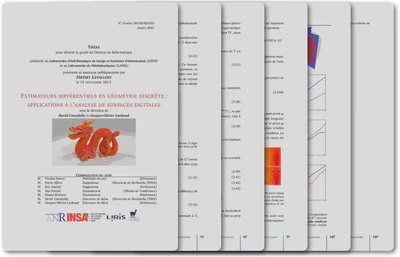Estimateurs différentiels en géométrie discrète : applications à l'analyse de surfaces digitales
Abstract
3D image acquisition devices are now ubiquitous in many domains of science, including biomedical imaging, material science, or manufacturing. Most of these devices (MRI, Backscatter X-ray, micro-tomography, confocal microscopy, PET scans) produce a set of data organized on a regular grid, which we call digital data, commonly called pixels in 2D images and voxels in 3D images. Properly processed, these data approach the geometry of imaged shapes, like organs in biomedical imagery or objects in engineering. In this thesis, we are interested in extracting the geometry of such digital data, and, more precisely, we focus on approaching geometrical differential quantities such as the curvature of these objects. These quantities are the critical ingredients of several applications like surface reconstruction or object recognition, matching or comparison. We focus on the proof of multigrid convergence of these estimators, which in turn guarantees the quality of estimations. More precisely, when the resolution of the acquisition device is increased, our geometric estimates are more accurate. Our method is based on integral invariants and on digital approximation of volumetric integrals. Finally, we present a surface classification method, which analyzes digital data in a multiscale framework and classifies surface elements into three categories: smooth part, planar part, and singular part (tangent discontinuity). Such feature detection is used in several geometry pipelines, like mesh compression or object recognition. The stability to parameters and the robustness to noise are evaluated with respect to state-of-the-art methods. All our tools for analyzing digital data are applied to 3D X-ray tomography of snow microstructures and their relevance is evaluated and discussed.

@phdthesis{PhDLevallois,
author = {Levallois, Jérémy},
month = {11},
school = {INSA-Lyon},
title = {Estimateurs différentiels en géométrie discrète : applications à l'analyse de surfaces digitales},
type = {Ph.D.},
year = {2015}
}